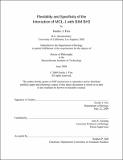Flexibility and specificity of the interaction of MCL-1 with BIM BH3
Author(s)
Fire, Emiko J. (Emiko June)
DownloadFull printable version (4.345Mb)
Other Contributors
Massachusetts Institute of Technology. Dept. of Biology.
Advisor
Amy E. Keating.
Terms of use
Metadata
Show full item recordAbstract
Interactions among proteins of the BCL-2 family regulate apoptosis - the process of programmed cell death. This thesis focuses on interactions between anti-apoptotic BCL-2 proteins and BH3 peptides derived from pro-apoptotic BCL-2 proteins, observed in earlier studies to occur with significant selectivity. In order to better understand determinants of specificity in anti-apoptotic/BH3 interactions, I have employed structural and binding studies of BIM BH3 point mutants with anti-apoptotic proteins. I report X-ray crystal structures of MCL-1 in complex with peptides of wild-type and three point mutant sequences of BIM BH3. Together, these structures exhibit a range of conformations within the complex. Structural change with respect to wild-type is most dramatic for an isoleucine-to-tyrosine mutant of BIM (I2dY). The larger residue is accommodated by helix [alpha]3 of MCL-1 and the BIM BH3 peptide helix shifting away from one another. In a phenylalanine-to-glutamate mutation (F4aE), the altered side chain is accommodated by a simple rotation of the side chain out of the hydrophobic pocket, a more modest structural change overall. I have also adapted SPOT array technology to qualitatively and simultaneously measure the interactions of anti-apoptotic BCL-XL and MCL-1 with a large number of surface-bound BH3 peptides. The best results were obtained when (i) longer BH3 peptides (26-mer vs. 20-mer) were employed, and (ii) antibodies were used to detect the binding of anti-apoptotic proteins. (cont.) The SPOT technique was used to perform substitution analyses, wherein each position of interest in a BH3 peptide is mutated to all possible amino acids (or a subset thereof). The results of these experiments identify several sites that, in the context of BIM, play a role in discriminating between MCL-1 and BCL-XL. Two of these sites are always occupied by small amino acids in known native BH3s, while two others are typically hydrophobic positions that become buried upon interaction with anti-apoptotic BCL-2 proteins. Together, these studies illustrate that the MCL-1 interaction with BIM BH3 is flexible enough to accommodate numerous point mutations, and that certain sites within BIM can be used to encode interaction specificity for both MCL-1 and BCL-XL.
Description
Thesis (Ph. D.)--Massachusetts Institute of Technology, Dept. of Biology, 2009. This electronic version was submitted by the student author. The certified thesis is available in the Institute Archives and Special Collections. Includes bibliographical references (p. 120-128).
Date issued
2009Department
Massachusetts Institute of Technology. Department of BiologyPublisher
Massachusetts Institute of Technology
Keywords
Biology.